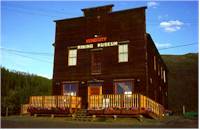KENO CITY & ELSA YUKON
For more than a decade before the Klondike Gold Rush, miners were working the gravel bars of the Stewart River in central Yukon. Gold was found in good quantities on the river but it was the discovery of silver in 1918 in the Mayo area that lead this area to become famous the world over for its riches.
Not far from Mayo Yukon was a small mining camp that one day become known as Keno City. In 1919 Louis Beauvette staked the Roulette silver claim on top of Keno Hill in the Mayo district. The mining company Keno Hill Ltd. which was a subsidiary of Yukon Gold Company, bought Louis claim from him along with a few others and began mining in around 1920. This area would prove to be one of the richest silver areas of the world.
Keno City which started out as a tent city quickly became a settlement of cabins, houses, a hotel, school, liquor store and a general store. There was even a sternwheeler called the Keno that was built in 1922 to haul silver ore down the Stewart River. The sternwheeler could be loaded with as much as 50 tons of silver ore.
Livingstone Wernecke a mining engineer arrived in 1921 to survey out some silver prospects in the area. He liked what he saw and invested almost $500,000 in properties and then started the Treadwell Yukon mining company. Wernecke soon had miners tunnelling in the Sadie-Ladue vein. It was about 120 metres long and averaged 50 cm wide, assaying 295 ounces of silver per ton. That's over 10,000 grams per ton.
Then in 1924, a man by the name of Charlie Brefault staked a claim up on Galena Hill. He named the claim Elsa after a sister. Then one day while out hunting he stumbles on his Lucky Strike claim with ore assaying 3,000 ounces of silver per ton. That's over 100,000 grams per ton!!
Then by 1932 falling silver prices and the exhaustion of the main deposit on Keno Hill, mining activity was reduced and people left. The school was closed in 1931 and the liquor store in 1933. Soon afterward, the site was virtually abandoned. Mining in Keno area has been an on again, off again episode ever since. The last big time operator of the mine was United Keno Hill Mines. They ran the mine from 1947 until they closed up shop in January of 1989. In 1980 between Keno and Elsa there were about 600 people. Today population is about 20.
Now with silver prices starting to climb and a renewed interest in minerals and mining, there is a new face looking over the claims of the Keno area. Alexco Resources is in the Keno area and has an exploration objective to unlock the value at the silver rich Keno Hill property located in the Yukon.





